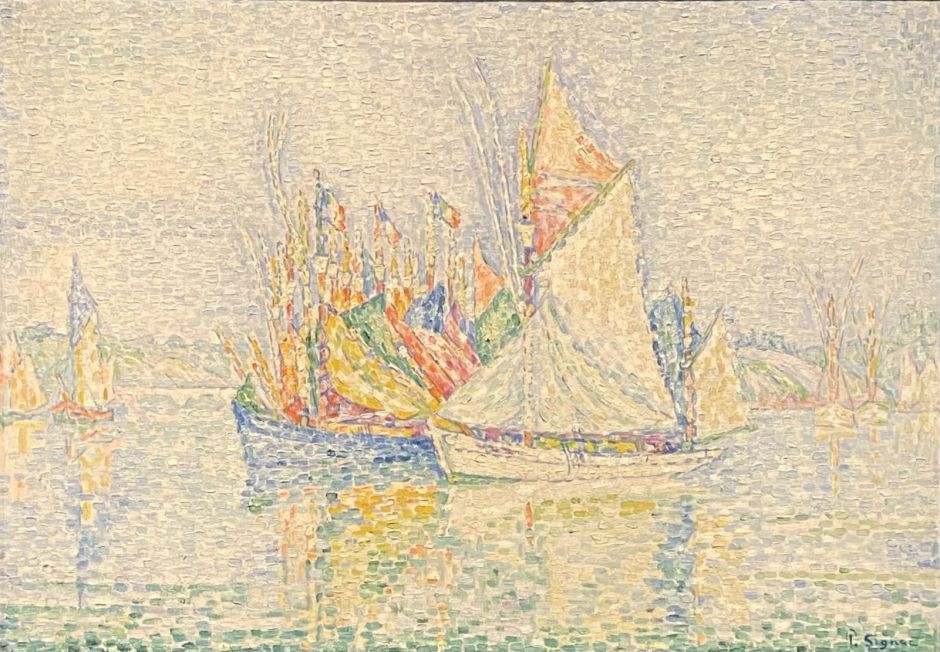For much of the First World War, Paul Signac (1863-1935) suffered from bouts of depression and painted little in oils. He spent much of his time during that period writing a monumental 1500-page manuscript on Stendhal as an art critic, which remains unpublished to this day. In 1918, he met Matisse again, and Albert Marquet. At the end of that year, the Bonnards arrived in Antibes, where Signac was living with his partner Jeanne Selmersheim-Desgrange and their young daughter.
In 1919, Signac sold his new yacht, the Sindbad, to raise money to buy back some of his own paintings, which he intended to form a collection to safeguard the inheritance of his young daughter, whom he later formally adopted. That summer he and his family went to the Alps, from where he visited Geneva, before returning to the Midi. At the end of the year, they left the south of France and set up home in Paris, in an apartment near the church of Saint-Germain-des-Prés, in the Sixth Arondissement.

The Green Pot, painted in 1920, is one of Signac’s very few still lifes. It’s also a curious departure from his pointillist style.
For the Venice Biennale in 1920, Signac, as commissioner for the French pavilion, decided to mount a special exhibition of Cézanne’s works, as well as exhibiting many others, including paintings by Matisse, Bonnard, Redon, and his own. Within two days of its opening, sixteen of his seventeen paintings were sold. He then spent the summer in La Rochelle, half way up the Atlantic coast of France.
Early in 1921, when he was back in Nice, he rented a property for the next three years in a small village nearby. He then spent the summer in Les Andelys, to the north-west of Paris and not far from Claude Monet in Giverny. In November, his watercolours were exhibited in Paris, following which Signac travelled to Concarneau, Groix and Lorient.
Early in 1922, as president of the Société des Artistes Indépendants, he wrote to Francis Picabia informing him of the rejection of two Dadaist paintings which he had submitted for its annual exhibition. That elicited a vitriolic response from Picabia.

In 1921, Signac painted another version of the Entrance to La Rochelle Harbour, with its twin towers. Despite an offer of ten thousand francs the following year from the state, Signac refused to sell this painting.

Signac spent the summer of 1922 in Brittany, from where he he painted the return of a sardine boat, in Le Sardinier, Locmalo (Les Tourelles). This was bought by the Galerie Bernheim-Jeune the following May, and sold on to a client.
Signac spent the summer of 1923 at Groix in Brittany and around Les Andelys.

He visited the small island of Groix several times to witness and sketch the annual blessing of its fishing fleet. In December 1923, he painted this finished oil version of the Blessing of the Tuna Fleet at Groix, which was exhibited the following year at the Salon des Indépendants, where it attracted high praise.
From 1924 until 1930, Signac spent most summers in Brittany.

Another painting made from sketches of the island of Groix is the Lighthouse at Groix, which he completed in 1925. This shows a tuna boat returning to port in the evening, by which time the rest of the fleet are drying their sails in harbour. This wasn’t exhibited until 1930.
The detail below shows his evolving facture, which remained steadfastly pointillist in his oil paintings.


With his apartment in Paris, Signac sketched many views of the River Seine and its bridges in watercolour. He painted Le Pont des Arts (Paris) in 1925, with its reference to his much earlier views of industrial sites along the river’s banks.

Three years later, he painted this panoramic view of Le Pont des Arts (1928), now in the Musée Carnavalet in Paris.
In early 1929, Signac started work on a commissioned series of watercolours of the ports of France. That took him first to the Midi in Spring, Brittany over the summer, and along the Channel coast into 1930. He concluded the series back on the Mediterranean coast in April 1931.
In December 1931, he met Mahatma Gandhi in Paris. The following year, the Depression started to affect his lifestyle, although he refused to sell paintings from his collection.

Late in his life, Signac painted almost exclusively in watercolour. This pale view of Concarneau, made in 1933, is among his last oil paintings.
At the end of 1933, Signac was at last promoted to commander in the Legion of Honour. At the end of the following year, he resigned as president of the Société des Artistes Indépendants, and was succeeded by Maximilien Luce. In 1935 he visited Corsica at last. Although he was invited to visit the USSR (Russia), which he declined.
In July 1935, Signac’s lung problems worsened, and he was confined to bed. His condition steadily deteriorated, and he died on 15 August, at the age of seventy-one, from a kidney infection resulting from his prostate cancer.
References
Cachin F (2000) Signac. Catalogue raisoné de l’Oeuvre Peint, Gallimard. ISBN 2 07 011597 6.
Ferretti-Bocquillon M et al (2001) Signac 1863-1935, Yale UP. ISBN 0 300 08860 4.
Ferretti-Bocquillon M et al. (2013) Signac, les Couleurs de l’Eau, Gallimard. ISBN 978 2 07 014106 7.

